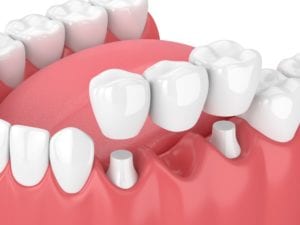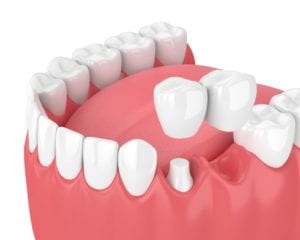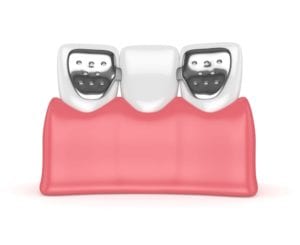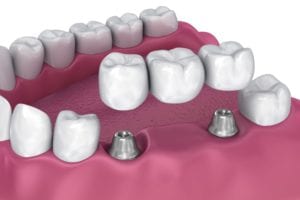The 4 Types of Dental Bridges

Dental bridges are a common dental restoration used to replace missing teeth, whether they have fallen out or have been extracted due to severe decay or structural damage. The structure of a dental bridge is just as its name suggests in that it bridges over the gap left by a missing tooth. The teeth on either side of the gap act as anchors, while the gap in the middle is filled with a fake tooth. Once placed, dental bridges have a natural appearance.
To determine if you are a candidate for a dental bridge, your dentist will perform an oral exam of the area where the dental bridge is to be placed. Depending on the location in the mouth, a dental bridge may or may not be ideal. The anchor teeth will also need to be evaluated to ensure they are strong enough to support a dental prosthetic. Dental x-rays and/or a CBCT scan may also need to be taken to evaluate the condition of the underlying structures.
If your dentist finds that you are a good candidate for a dental bridge, the next thing that will need to be determined is what type of dental bridge is best for you. There are four types of dental bridges that offer different options depending on the individual case. Here are the four different types of dental bridges:

Traditional Dental Bridge
A traditional dental bridge is the most commonly used type of dental bridge and you may even be familiar with it. This type of bridge is composed of one dental crown adhered to both the surrounding teeth with a fake tooth or teeth in the between. With this, the dental crowns provide anchor points, while the fake tooth “bridges” the gap. One main benefit of traditional bridges is their strength. However one of the downsides are that they require modification of the two adjacent teeth.

Cantilever Dental Bridge
Cantilever dental bridges deviate in structure from traditional dental bridges and only use a single anchor tooth. They are not used as frequently as other bridge types and often can only be placed towards the front of the mouth. Cantilever bridges are not advised for the back of the mouth because they can place too much strain on a single tooth. If a cantilever bridge can be safely placed, it can save both time and money. However, there are few cases where this type of bridge can be placed safely.

Maryland Bonded Bridge
A Maryland bonded bridge uses the same structure as a traditional dental bridge, however instead of using dental crowns as anchors, a metal or porcelain framework is used. This framework eliminates the need for modification of the adjacent teeth and is simply adhered to the back instead. Essentially, Maryland bonded bridges provide a conservative and more affordable alternative to traditional bridges. However, their strength depends on the strength of the adhesive and metal frameworks can cause tooth discoloration.

Implant-Supported Bridge
Implant-supported dental bridges use the same structure as traditional bridges, however they are anchored in place with dental implants. Because of this, implant-supported bridges do not require adjacent teeth and can be used to span large gaps with multiple missing teeth. Dental implants are also known for their strength, durability, and ability to restore normal function. However, this type of dental bridge requires a more invasive placement procedure and a recovery period.
These four types of dental bridges offer dental patients will missing teeth a variety of restoration options. Traditional and Maryland bonded bridges can be used in situations where there are teeth on either side of the gap, Cantilever bridges can be used in situations with a tooth on one side of the gap, and implant-supported bridges can be used when there are multiple missing adjacent teeth. While each type of dental bridge has its own pros and cons, ultimately only a general dentist can advise you on which type is best for you. Choosing the best dental bridge for you is a bridge to a better smile.






Recent Comments